
J Stiff & Sons Lambeth Art Pottery Vase (1880)
An art pottery vase by J Stiff and Sons Lambeth English circa 1880 27 cm high 24 cm wide, James Stiff & Sons were based at the London Pottery, High Street, Lambeth. The firm was established in 1751 and produced assorted terracotta and stoneware products…

Doulton Lambeth 'Carrara' Antique English Porcelain Vase, 19th Century
Doulton Lambeth 'Carrara' antique English porcelain vase with hand painted country scene vignette, 19th century, factory mark to base, 31 cm high

Doulton Lambeth Art Pottery Vase with Bird Decoration, 1890
Doulton Lambeth Art pottery vase with hand painted bird decoration on green ground by C. Vargas, circa 1890, impressed and factory stamps to base with artist's monogram, 21 cm high

Doulton Lambeth Mantle Vase with Floral Decoration, Early 20th Century
Doulton Lambeth English pottery mantle vase with floral decoration and gilded highlights, early 20th century, stamped 'Doulton Lambeth, Carrara', 36 cm high

Doulton Lambeth Silicone Ware Vase, Glazed Interior, 11 cm Height
Doulton Lambeth, Silicone ware vase with glazed interior (some losses), height 11 cm

Art Deco Doulton Lambeth stoneware vase with floral decoration
Doulton Lambeth stoneware vase, Art Deco stoneware vase decorated with flowers by Bessie Newberry

Royal Doulton Arts & Crafts Vase, Doulton Lambeth Stoneware, 15cm
Royal Doulton Arts & Crafts vase, Doulton Lambeth stoneware, height 15 cm

Royal Doulton Arts & Crafts Vase, Doulton Lambeth Stoneware, 15cm
Royal Doulton Arts & Crafts vase, Doulton Lambeth stoneware, height 15 cm

Royal Doulton Lambeth Arts and Crafts Vase with Country Women
A Royal Doulton Lambeth pottery Arts and Crafts vase, tube lined decoration of country women in a landscape, blue and green toned glaze, impressed mark to base. 15 x 21.5 cm.

Royal Doulton Lambeth Pottery Vase with Fruit Motif, Early 20th Century
Royal Doulton Lambeth Pottery vase with fruit motif on blue and celadon ground, early 20th century, impressed and black factory marks to base, 20.5 cm high
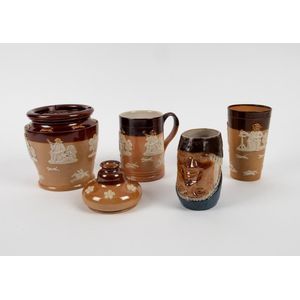
Royal Doulton and Doulton Lambeth Pottery Collection, 19th/20th Century
Royal Doulton and Doulton Lambeth Pottery tobacco jar, tankard, beaker, vase and rare 'Marriage day, after Marriage' mug, 19th/20th century, (5 items), impressed factory marks to the bases, the mug 12 cm high

Doulton Lambeth Stoneware Twin Handled Vase by Edith Lupton
19th century Doulton Lambeth stoneware twin, handled vase, of classical form, modelled by Edith Lupton, with spreading lip flanked by scrolled handles, the body decorated with leaves and seed pods, in tones of blue, brown and green, impressed and initials…

Doulton Lambeth Stoneware Vases with Sgraffito Landscape Decoration
Pair of Doulton Lambeth stoneware vases, by Hannah Barlow and Frances E. Lee, c. 1891-94, of baluster form with flared bases and elongated necks, each decorated with a unique sgraffito central band of young girls amongst sheep in a landscape, artists'…

Hannah Barlow Lion Scene Stoneware Vases
Pair of Doulton Lambeth stoneware vases, by Hannah Barlow, c. 1900, of baluster form with flared bases, each decorated with a unique sgraffito central band of a scene of lions in a landscape, artist's signature incised to bases, factory rosette mark…

Hannah Barlow & Frances E. Lee Doulton Vases
A pair of Doulton Lambeth stoneware vases decorated by Hannah Barlow & Frances E. Lee, of tapering form, with a slender fluted neck, decorated with a central band of sgraffito sheep, incised markers mark and impressed rosette England factory mark to…
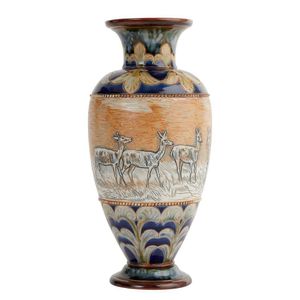
Hannah Barlow Doulton Lambeth Vase, circa 1900
A Doulton Lambeth stoneware vase decorated by Hannah Barlow, circa 1900, baluster in form, the central band decorated with a scene of sgraffito doe in a landscape setting, incised marker mark and impressed rosette England factory mark to underside of base…

Art Nouveau Stoneware Vase by Eliza Simmance
A Doulton Lambeth stoneware vase decorated by Eliza Simmance, circa 1900, baluster in form, with a fluted and frilled neck, decorated overall with repeating floriate motifs in the Art Nouveau taste, incised markers mark and impressed rosette England…

Hannah Barlow & Eliza Simmance Doulton Lambeth Vase
A Doulton Lambeth stoneware vase decorated by Hannah Barlow & Eliza Simmance, circa 1900, of baluster form, with a central band of sgraffito cattle in landscape setting, incised markers marks and impressed rosette England factory mark to underside of base…

Hannah Barlow Doulton Lambeth Vase, 1887
A Doulton Lambeth stoneware vase decorated by Hannah Barlow, dated 1887, of baluster form, with a central band of sgraffito lions and lionesses in landscape, incised markers mark, impressed date mark of 1887 and rosette factory mark to underside of base,…

Doulton Lambeth Vase with Pate-sur-Pate Ducks
A Doulton Lambeth stoneware vase decorated by Florence Barlow & Francis E. Lee, circa 1880, bottle shaped with a slender neck, decorated with scrolling foliage surrounding a central oval cartouche featuring a scene of pate-sur-pate ducks amongst grasses,…

Florence Barlow Doulton Lambeth Stoneware Vase, 1882
A Doulton Lambeth stoneware vase decorated by Florence Barlow, dated 1882, of tapering form, decorated with two oval cartouches of foliate motifs, flanked by raised pate-sur-pate sparrows and foliage on a stippled ground, incised markers mark, impressed…
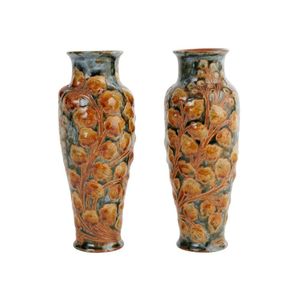
Doulton Lambeth Oak Leaf Vases by Butler, 1905
A pair of Doulton Lambeth stoneware vases decorated by Frank a. Butler, circa 1905, each of slender form, decorated with repeating relief moulded oak leaf designs, incised markers mark and impressed circle, lion and crown factory mark to underside of base…

Doulton Lambeth Vases by Florence E. Barlow
A pair of Doulton Lambeth vases decorated by Florence E. Barlow, circa 1905, each of slender baluster form, with a fluted neck, decorated with floriate motifs and pate-sur-pate geese amongst grasses on a stippled ground, incised markers mark and impressed…
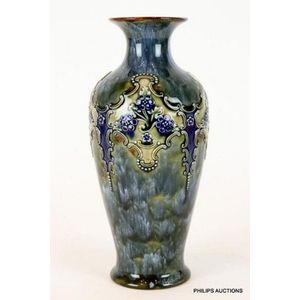
19th Century Royal Doulton Lambeth Vase
A Royal Doulton Lambeth vase, model no X9515, late 19th century, the baluster form vase with a narrow neck and an everted rim, decorated with a band of floral reserves and beading on mottled blue ground, impressed factory mark and artist mark Mh' to base.…

Doulton Lambeth Stoneware Specimen Vase, 18.5cm
Doulton Slaters Lambeth stoneware specimen vase, 18.5 cm high

Doulton Lambeth Stoneware Specimen Vase (22.5 cm)
Doulton Lambeth stoneware specimen vase, 22.5 cm high

Magnolia-decorated Doulton Lambeth art pottery vase, 19th century
Doulton Lambeth Art pottery vase decorated with magnolias, 19th century, stamped 'Doulton Lambeth, faience, 1877', with additional artist's monogram, 34 cm high

Doulton Lambeth Pottery Vase by Frank Butler
A Nouveau Doulton Lambeth Pottery vase by Frank A. Butler ovoid with flaring neck. Caramel, brown, blue tube lined in breaking wave design. Impressed marks and incised initials Fab on base, height 29 cm

Nouveau Foliate Vase by Frank Butler
An Art Nouveau Doulton Lambeth vase by Frank Butler caramel, brown, blue tube lined with a highly stylised Nouveau foliate pattern. Impressed marks and incised initials Fab on base, height 26 cm.

Doulton Lambeth Arts & Crafts Vase with Silver Rim
Doulton silicon Lambeth Arts & Crafts vase, of tapered form with a short cylindrical neck simulating riveted copper and leather, with English hallmarked sterling silver rim, impressed marks and number to base, height 11 cm

Doulton Lambeth Gourd Vases with Floral Decor
Pair of Doulton Lambeth vases, of gourd form, decorated with flowers and foliage, in tones of pink, green and yellow on a blue ground, height 28 cm (2)

Doulton Lambeth Art Pottery Vase with Etched Flower Pattern
A large Doulton Lambeth silicon ware Art pottery vase, decorated with a continuous etched flower pattern within stylised borders, impressed factory marks and incised signature to base, 44.5 cm high

Gilt Decorated Royal Doulton Lambeth Vase on Marble Ground
Vintage Royal Doulton Lambeth vase gilt decorated, on marble type ground, marked to base, height 19 cm.

19th Century Doulton Lambeth Stoneware Vases with Floral Patterns
A pair of 19th century Doulton Lambeth stoneware vases, tapering cylindrical form with wide neck, decorated with incised floral patterns, impressed mark, date, and various scratched initials to base included E.D.L for Edith D Lupton one of Doulton's…

Doulton Lambeth Stoneware Vase by Mark Marshall
A rare Doulton Lambeth stoneware vase by mark V. Marshall (Act. 1878-1912), of compressed ovoid shape with foliate pattern to the walls incorporating sculpted elements. In typical majolica tones on a cobalt ground. Incised artist's monogram and impressed…

Royal Doulton Art Nouveau Vase
An impressive Royal Doulton Lambeth stoneware Art Nouveau vase, inverted baluster form, elongated neck, with tube lined Art Nouveau floral decoration, impressed mark to base and incised artist's initials Rb('). Height 47 cm.

Art Nouveau Stoneware Vase by Royal Doulton
A Royal Doulton Lambeth stoneware Art Nouveau vase, inverted baluster form and decorated with Art Nouveau florals and leaves. Height 23 cm.

Vintage Royal Doulton Lambeth Jug Vases - Blossom Decorated
Pair vintage Royal Doulton Lambeth jug vases, blossom decorated on cobalt blue ground, impressed mark to bases, height 12 cm each.

Vintage Doulton Lambeth Table Vase with Blossom Decoration
Good Vintage Doulton Lambeth table vase blossom decorated on cobalt blue ground, with panels of brown glaze decoration, impressed mark to base, height 21 cm
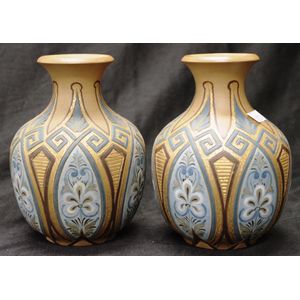
Blue and Gold Stoneware Vases (5 words)
Pair of Doulton Lambeth silicon stoneware vases with ornate blue & gilt decoration, height 15 cm.

Doulton Lambeth Hunting Scene Tumbler Vase
Doulton Lambeth stoneware tumbler vase traditionally decorated with hunting figures 13 cm height

Lambeth Doulton Hand Painted Vase with Figures & Grapevines
A Lambeth Doulton hand painted vase with figures & Grapevines, 40 cm.

Florence Barlow Stoneware Vase with Birds and Foliage
A Doulton Lambeth stoneware baluster form vase by Florence Barlow, decorated with birds and foliage, 28 cm high

Doulton Lambeth Wildflower Vase, 1900
A Doulton Lambeth Australian wildflower vase, circa 1900, painted with a continuous frieze of Sturt's desert pea, printed and impressed factory marks to base, 'L8928', artist mark in script 'Ejg/Ec/935'., 35 cm high. Other Notes: Emily J. Gilman was…

Doulton Slaters Patent Vases, Exotic Eastern Shape
A pair of Doulton Slaters patent vases, circa 1900, with Doulton Lambeth and Slater's patent stamp, vases of exotic Eastern shape with trumpet rims and slender baluster moulded majolica necks to broad baluster bodies with textured floral designs in iron…

Art Nouveau Doulton Lambeth Stoneware Vases by Maud Bowden
A pair of Doulton Lambeth stoneware vases, by Maud Bowden, Tube-lined Art Nouveau stylised foliate and floral design on shoulder. Royal Blue body with tan olive neck. Both have an incised Doulton mark used 1922-1956, and signed MB (Maud Bowden; Senior…

Doulton Lambeth Stoneware Vase with Floral Frieze
Doulton Lambeth stoneware vase, of baluster form, decorated with floral frieze and beaded borders, in tones of green, blue and brown, height 26.5 cm

Mottled Glaze Doulton Lambeth Earthenware Vase
Doulton Lambeth earthenware vase, of squat form, decorated with a mottled glaze, in tones of blue, green, maroon and white, height 15 cm

Florence Barlow Doulton Lambeth Stoneware Vase with Budgerigars
A Doulton Lambeth stoneware vase by Florence Barlow, of elongated baluster form with a flared neck flanked by scrolled handles, having all over moulded, incised and piped decoration in shades of blue and ochre, with a scroll framed reserve enclosing a…

Florence Barlow Stoneware Vases with Parrot Design
A large pair of Doulton Lambeth stoneware vases by Florence Barlow, each of baluster outline decorated with a band of Art Nouveau scrolls to the flared neck, the body with a design of parrots and tropical flowers on a matted ground, impressed and incised…

Blue and Brown Doulton Lambeth Vase, 1884
Doulton Lambeth vase R 1884 blue flowers and brown leaves 15 cm high,

Large Doulton Lambeth Pottery Vase - 39.5 cm Tall
A large Doulton Lambeth Pottery vase height 39.5 cm

Doulton Lambeth Floral Stoneware Vase - Signed (24cm)
Doulton Lambeth stoneware vase with floral decorations, signed to base, height 24 cm

Kingsware Jug and Silicon Vase by Royal Doulton
Royal Doulton Kingsware jug decorated with 'The Squire', 17 cm height, together with a Doulton silicon Lambeth ovoid vase, 16 cm height
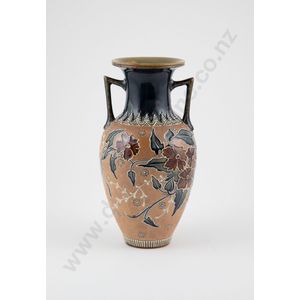
Doulton Lambeth Slaters Patent Vase with Floral Decoration
Doulton Lambeth 'Slaters' patent vase two handled ovoid shape, decorated with flower heads and leaves, impressed marks and stamp for Art Union of London, 24.5 cm height

Autumnal Doulton Lambeth Stoneware Vase, 28.5 cm Height
Doulton Lambeth stoneware vase ovoid shape decorated with foliage in Autumnal colours, 28.5 cm height

Louisa Davis Signed Royal Doulton Stoneware Vase
A Royal Doulton Lambeth vase, signed by Louisa Davis. This stunning stoneware vase is of bulbous shape standing on a narrow rounded pedestal foot and with a short trumpet shaped top. The body of the vase is decorated with an incised trailing floral and…

Doulton Lambeth Stoneware Vase with Raised Flower Frieze
Large Doulton Lambeth stoneware vase, with a folding lip and baluster body, decorated with raised flower head frieze surrounded by beaded borders, in tones of blue, brown and green, impressed marks to base, a/f, height 27 cm

Hannah Barlow Sheep Vase Doulton Lambeth Stoneware 1879
Hannah Barlow Doulton Lambeth stoneware vase with sheep decoration, circa 1879, impressed mark 'Doulton Lambeth' and Barlow's monogram, 18.5 cm high

Royal Doulton Lambeth Vases - Pair with Repair
Pair of Royal Doulton Slaters patent Lambeth vases, height 27 cm, one vase repaired to base

Doulton Lambeth Stoneware Vases by Ethel Beard
Pair Doulton Lambeth stoneware vases. By Ethel Beard, of square section bottle vase form. Impressed factory mark, and incised initials 'EB' to base. Height 16 cm

Hannah Barlow Signed Donkey Vase, Doulton Lambeth (1872-1906)
Antique Doulton Lambeth Hannah Barlow signed vase etched donkey decoration, marked to base, and the inscribed initials of Hannah Barlow, circa 1872-1906, height 21 cm.

Art Nouveau Doulton Lambeth Vase by Florrie Jones
Art Nouveau Doulton Lambeth vase c1900, stamped 'FJ' (Florrie Jones) to base, height 21.5 cm

Doulton Lambeth Flower Vase, 40cm Height
Large Doulton Lambeth flower vase, with Doulton Slaters patent mark, height 40 cm

Doulton Lambeth Foxgloves Vase - 43.5 cm High
Large Doulton Lambeth Foxgloves ceramic vase mark to base measures 43.5 cm high.

Doulton Lambeth Faience Vase with Iris Decoration
Doulton Lambeth faience vase, of baluster form with a spreading lip, the body decorated with iris, the neck decorated with iris medallions, in tones of green, brown, yellow and dark blue, impressed and hand painted marks to base, initalled C.W, height 50…

Doulton Lambeth Vase with Floral Panels and Racemes
A large Doulton Lambeth vase, tapering cylindrical shape with floral panels and racemes on a mottled green-blue ground, height 32 cm

Victorian Hare Group with Hexagonal Vase
A late Victorian Doulton Lambeth figure group, two hares sit either side of a hexagonal vase which is inscribed 'The Waning of the Honey Moon', on oval decorated base, impressed marks to base, attributed to George Tinworth. 13 cm x 6.5 cm x 12 cm.

Victorian Doulton Lambeth Table Vase - Rare Design
Good Victorian Doulton Lambeth table vase rare design, marked to base and initialed 'MA,' (Mar Aitken), circa 1882, height 22 cm

Pink and White Flower Vase by Doulton Lambeth Pottery
A Doulton Lambeth Pottery vase, tubelined with white flower sprays decoration on a pink ground, the rim glazed green. Numbered 726, stamp and signed to base. Height 39 cm

Royal Doulton Aesthetic Period Garden Vase by Florrie Jones
A rare Royal Doulton Lambeth glazed pottery flasked shape vase by Florrie Jones, depicting garden arbours of aesthetic period with impressed marks to the base

Art Nouveau Poppy Vase by Leslie Harradine
Royal Doulton Lambeth Art Nouveau posy vase, by Leslie Harradine, c.1912-1956, moulded in relief with poppies, in tones of blue, white and green, impressed marks and numbered H28, incised initials 'LH' to base, height 12 cm

Art Nouveau Doulton Lambeth Vase with Budgerigars
Stunning Florence Barlow for Doulton Lambeth twin handled stoneware vase, c.1891-1902, of tapering ovoid form, with pate-sur-pate budgerigars within shield medallions on a ground decorated with Art Nouveau motifs, in tones of brown, blue and green,…

Hannah B Barlow's New Forest Pony Vase
Doulton Lambeth vase glazed Pottery footed mantle vase. With incised decoration. Depiciting Ponies in the New forest. By Hannah B Barlow. Incised monogram to base H.B.B. Incised monogram A.B for Acidalia Beck (1882). Impressed 'Doulton Lambeth, England'…

Hannah Barlow Sheep Vase
Doulton Lambeth vase stoneware. With incised decoration depicting a flock of sheep. By Hannah Barlow. Signed to base with incised monogram 'H.B.B'. Assistant marks for Lucy & Barlow & Emma Martin. Impressed 'Doulton Lambeth', date 1883. On turned timber…

Doulton Lambeth Sparrow Mantle Vases by F.E Barlow
Pair of Doulton Lambeth mantle vases decorated stoneware. With Sparrows on a branch in Pate. Sur pate glaze by Florence E Barlow. Base incised with initials F.E.D.B, stamped Doulton Lambeth, England. Impressed shape number 1055, pattern 424, lower case H.…

William Rowe Royal Doulton Persian Ware Vase
Royal Doulton vase Persian Ware squat vase. By William Rowe, circa 1920, stamped to base (printed) Doulton Lambeth. & hand painted P54. Height 10.5 cm

Doulton Lambeth Stoneware Ewer with Hand Painted Flowers
Doulton Lambeth ewer Carrara stoneware vase. Decorated with hand painted flowers. By Rosa Keen. Modelled by Frank a Butler. Assistant Edith Woodington, circa 1890. Height 29 cm. (a/f handle repaired)

Royal Lambeth Vases with Flower Decoration
Pair of Royal Lambeth vases Carrara stoneware. Decorated with flowers. By Kate Rogers (1880 - 1898). Impressed & printed mark Doulton - Lambeth to base. Model 8315. Initials K R, dated 1897. Height 30 cm

Doulton Lambeth Floral Vases by N. Straker
Pair of Doulton Lambeth vases Carrara. Floral decorated. By N Straker. Hand painted mark to base N.S. & marks for Miss M driver, Miss a Dunlan & Florence Earl. Height 18 cm

Doulton Lambeth Mantle Vase with Pottery Flowers and Animals
Doulton Lambeth mantle vase blue silicon stoneware. Decorated with applied glazed Pottery flowers. Insects, mice & birds. By John broad (1873 - 1919). Incised monograms for J.B (John broad. C.L Charlotte Lamb, Miss L Francis & Mary Ann Thomson (1875 -…

Doulton Lambeth Flask Vase with Floral & Bird Decorations
Doulton Lambeth flask vase silicon Ware. Decorated with floral swags & birds. Artists marks for Mary Budden (1882). Lizzie French (1879 - 1882). & Florence Bowditch (1852). Height 26 cm. (a/f repaired finial)

Doulton Lambeth Tapered Vase with Flared Necklace
Doulton Lambeth tapered vase silicon Ware. With flared necklace. Impressed marks to base Doulton silicon Lambeth. Artists mark for Georgina Pearson & nn. Height 23 cm. (a/f repaired base, rim)

Doulton Lambeth Chineware Vase with Floral Decoration
Doulton Lambeth vase stoneware mantle vase. Decorated with Chineware. Textured pattern overlaid with Piped floral decoration. By Florence C Roberts (1879 - 1930). Incised monogram to base F.R & 233. Impressed mark Doulton Lambeth, England. (post 1891) L.W…

Blue and White Floral Royal Doulton Vase
Royal Doulton Lambeth vase blue & white floral decoration. Over gold gilt band. On mottled brown glaze. Impressed marks to base Royal Doulton, England & Doulton Slaters patent. Artist mark Miss H Toland 7085. Height 17 cm. (a/f to base)

Royal Doulton Lambeth Vase with Floral Decoration
Royal Doulton Lambeth vase blue, white & green floral decoration. Gold gilt band on green ground. Impressed marks to base Royal Doulton England 7074 ft' 60941. Height 14 cm

Royal Doulton Lambeth Blue Vases with Gold Decoration
Pair of Royal Doulton Lambeth vases repeating gold gilt decoration. On blue ground. Impressed mark Royal Doulton. & artists mark. Height 14 cm

Mary Butterton Hand-Painted Faience Vase
Doulton Lambeth vase faience Pottery jardiniere. Hand painted decoration with flowers. By Mary Butterton. Marked by monogram for Mary Butterton. Plus initials for Elizabeth Shelley dated 1881. Height 16 cm. (a/f minor scratch to glaze)

Doulton Lambeth Faience Vase with Spring Flowers
Doulton Lambeth vase faience Pottery ovoid shaped. With circular foot & flared lip. Hand painted decoration of spring flowers. Possibly by Beatrice Durtnall. Painted monogram of the letter D to base. Impressed 'Doulton Lambeth Faience' mark to base.…

Isabel Lewis Floral Faience Ewer Vase
Doulton Lambeth ewer vase faience floral decorated. By Isabel Lewis (1876 - 1897). Impressed base stamp Lambeth Faience-Doulton (1873 - 1914) pre 1891. Height 34 cm. (a/f cracked)

Doulton Lambeth Faience Vases with Lily Sprays
Pair of Doulton Lambeth vases faience Ware. Amphora shaped mantle vases. Decorated with hand painted sprays of Asial Lillies. By Helen a Arding (1877 - 1883). Monogramed to base H.A, model pattern 255. Impressed Doulton Lambeth - faience. Mark & impressed…

Doulton Lambeth Faience Vases with Aster Daisies
Pair of Doulton Lambeth vases faience Ware. Glazed Pottery footed mantle vases. Baluster shaped. Decorated with hand painted Aster daisies. By a Euphemia Thatcher. Signed with monogram E.T. Impressed Doulton Lambeth faience mark. & printed mark to base.…

Hand-painted Doulton vases with floral decoration
Pair of Doulton (Lambeth) vases long neck bud vases. With hand painted floral decoration. By (possibly) John Huskinson (1878 - 1883). Artist letter H to base. Impressed marks Doulton & 1754. Dated Dec 1884. Height 19 cm. (a/f chipped & repaired)

Doulton Lambeth Faience Vases with Marine Creatures & Putti
Pair of Doulton Lambeth Crown faience vases china mantle vases. Decorated with marine creatures & putti. By John Eyre. Monogrammed artists initials J.E. Impressed mark to base Doulton Lambeth. Printed mark Crown Doulton Lambeth, England to base, circa…

Royal Doulton Crane Vases by Hannah Barlow, 1874
Pair of Royal Doulton Lambeth vases stoneware mantle urns. Decorated with cranes in flight. By Hannah Barlow. Signed to base with monogram H.B.B. Model no 195, date impressed for 1874. Height 29 cm. (a/f one vase professionally repaired)

 Loading more...
Loading more...